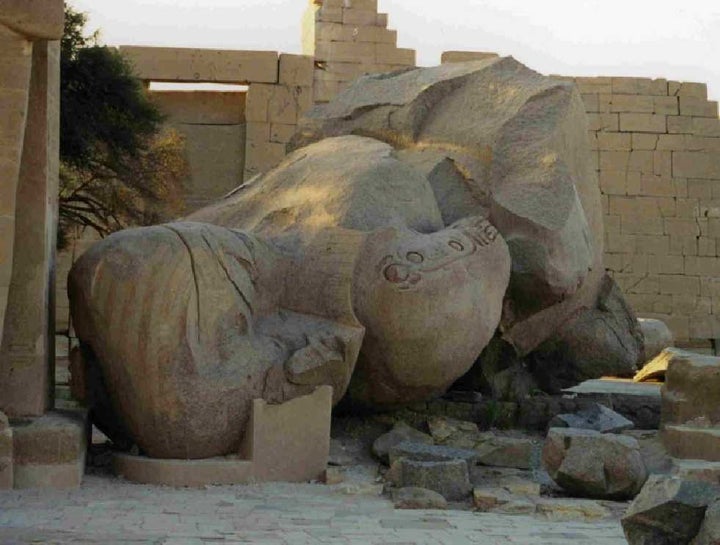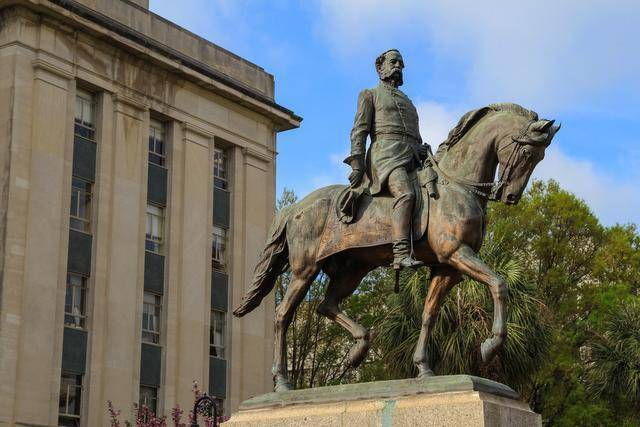
Fallen Ramsses II statue inspired Shelley’s “Ozymandias.”
“And on the pedestal, these words appear:/ My name is Ozymandias, King of Kings; Look on my Works, ye Mighty, and despair!” - “Ozymandias,” Percy Bysshe Shelley
Possibly among the greatest failures of formal K-12 schooling has been not only what students are taught in history and social studies, but how history as a discipline has been misrepresented (paralleled, I think, by a similar message about science) as fixed and objective.
History is never fixed or objective, but always a living document — one written by those who have power, who have access to the telling.
A vivid example of this fact is how Howard Zinn has been discounted as more an activist than a historian because his work was committed to changing the perspective of history from the power elites to the people. Zinn was both praised and rejected, for example, when his work asked everyone to rethink Christopher Columbus and the concept of “discovering” lands already occupied. Zinn challenged whose presence matters.
Nonethe less, traditionalists remain trapped in the belief that history has been and can be objective, can avoid being political, and once anyone seeks to better understand a person or the narratives of the past, those traditionalists shout “revisionism,” as if that new understanding is something to be shunned.
That any human expression can be objective, apolitical, is a naive position. In response to those arguing Ivanka Trump’s new book is not a political work, Ani Kokobobo reveals:
She claims she wrote it before her father’s election, “from the perspective of an executive and an entrepreneur.” And though they criticize her for being trite, derivative, out of touch and racially tone-deaf, most readers have accepted the premise that this is a largely apolitical book....Yet as every scholar of literature knows, each book contains what theorist Fredric Jameson has dubbed a “political unconscious.” In other words, through the sheer act of narrating, a book reinforces one particular point of view while policing others.
This last point perfectly captures the reality of all history. And thus, the great irony of slurring history with “revisionism” is that history as a living document should be a constant act of retelling history in an effort to make the story clearer, more accurate ; revisionism is not an erasing of history.
Teaching that Washington never told a lie or that Columbus discovered America was in the moment an act of revisionism since they both are distortions in the name of someone’s agenda. To seek ways that better portray Washington and how Europe reaching the West began what is now the U.S. and other countries is the great promise history and historical thought can offer a free people.
In a time now characterized by the rise of Trump (as a marker for nationalism masking racism) against the #BlackLivesMatter movement (as a confrontation of the racial inequities in policing and the justice system), we become witnesses to the power of monuments to maintain racism: calls for renaming Tillman Hall at Clemson University, New Orleans removing Civil War statues, and near my university, black students petitioning to rename a high school.

The Wade Hampton monument.
These efforts to revise history, bending it toward a greater clarity, a more credible truth, cannot be divorced from how political, media, and public responses frame calls for dismantling monuments to the flawed and often awful past.
As a recent example, local coverage of students’ petitioning to rename a high school has a revealing title, Petition calls for dropping ‘racist’ name of Wade Hampton, and lede paragraph:
Wade Hampton III was a Confederate lieutenant general, one of the largest slaveholders in the Southeast and, by today’s standards, a blatant “racist,” according to historians.
When I raised concern about the word racist being placed in quote marks in the article, the journalist noted that it was to identify “charged language” and to avoid bias.
Couched within the lingering racism driven by denying and tip-toeing about confronting racism is the pervasive failure of both-sides journalism that refuses to acknowledge that some perspectives are credible while others are not.
The article itself quotes a historian acknowledging the fact of racism that the article treats as “charged language,” and thus, possibly lacking credibility.
A revised view of history allows us to acknowledge what is not debatable ― many with power in the past, mostly white men, were racists ― and is essential for helping us resolve what is debatable , whether or not we rename buildings/institutions and dismantle monuments.
If we believe in an optimistic view of human history, associated with Martin Luther King Jr. (“How long? Not long, because the arc of the moral universe is long, but it bends toward justice”), that we can somehow shape the world for the good of all, there is much to dismantle — the monuments grounded in human actions devoid of a more refined moral view as well as a tentative discourse that refuses to name and steps around the very facts that allow us to engage in robust debate.
It is an anemic approach to wait for monuments to crumble under their own baselessness, and thus, it is our duty to hasten the process on the path to justice, even when that duty is hard and seemingly unpopular.
We make history with each step we take, and we reshape history necessarily in that procession.